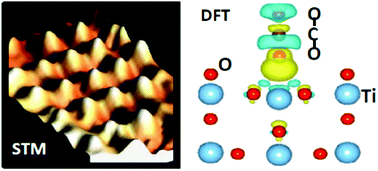Imaging the ordering of a weakly adsorbed two-dimensional condensate: ambient-pressure microscopy and spectroscopy of CO2 molecules on rutile TiO2(110)†
Abstract
Disorder–Order transitions in a weakly adsorbed two-dimensional film have been identified for the first time using ambient-pressure scanning tunneling microscopy (AP-STM) and X-ray photoelectron spectroscopy (AP-XPS). As of late, great effort has been devoted to the capture, activation and conversion of carbon dioxide (CO2), a ubiquitous greenhouse gas and by-product of many chemical processes. The high stability and non-polar nature of CO2 leads to weak bonding with well-defined surfaces of metals and oxides. CO2 adsorbs molecularly on the rutile TiO2(110) surface with a low adsorption energy of ∼10 kcal mol−1. In spite of this weak binding, images of AP-STM show that a substantial amount of CO2 can reside on a TiO2(110) surface at room temperature forming two-dimensionally ordered films. We have employed microscopic imaging under in situ conditions, soft X-ray spectroscopy and theory to decipher the unique ordering behavior seen for CO2 on TiO2(110).



 Please wait while we load your content...
Please wait while we load your content...
